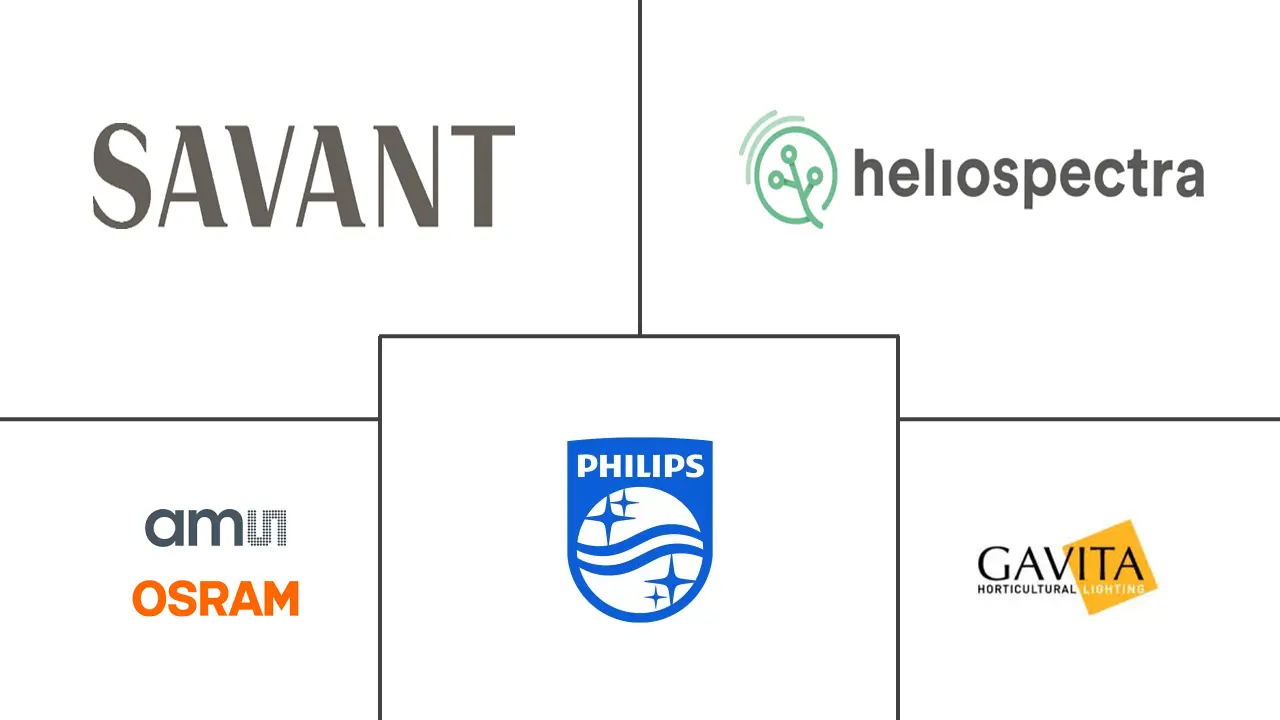LED Farming Market Size and Share
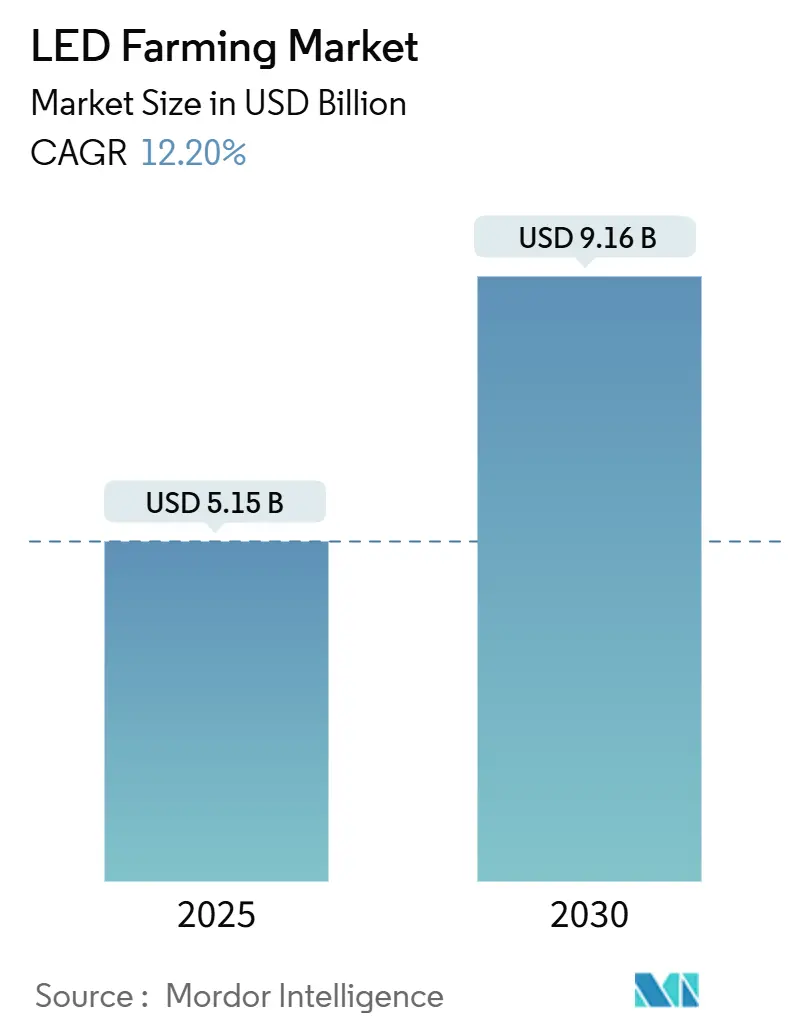
LED Farming Market Analysis by Mordor Intelligence
The LED Farming Market size is estimated at USD 5.15 billion in 2025, and is expected to reach USD 9.16 billion by 2030, at a CAGR of 12.20% during the forecast period (2025-2030).
The LED farming market has been growing significantly due to increasing demand for sustainable and efficient farming practices, advancements in LED technology, and the need for food security amidst a growing global population. The rise in greenhouse numbers worldwide also supports market growth. For instance, according to the Government of Canada, the number of greenhouses in Canada increased from 858 in 2020 to 920 in 2023. This is because of its ability to provide specific wavelengths for optimal crop growth while minimizing energy usage.
Increased reliability, energy efficiency, product diversification, and reduced long-term costs are driving LED lighting adoption in vertical farms. The growth of urban populations in cities such as New York, Chicago, Milwaukee, Toronto, and Vancouver has spurred the establishment of indoor farms, both in shipping containers and building-based forms, to meet the demand for fresh produce and livestock feed. For instance, in 2022, FarmBox Foods LLC launched a Hydroponic Vertical Fodder Farm. These developments are increasing the demand for LED lighting in controlled growing environments.
Countries leading in LED farming adoption include the United States, Japan, the Netherlands, Germany, and South Korea due to their higher adoption of vertical farms. By cultivating crops year-round in controlled environments, farmers can overcome traditional agricultural limitations and increase the availability of fresh produce. The growth of controlled environment farming technologies and the expansion of indoor farming practices continue to drive market growth during the forecast period.
Global LED Farming Market Trends and Insights
Affordability of LEDs is Driving their Adoption
Vertical farming has initiated a significant trend in the light-emitting diode (LED) technology market. The high energy efficiency of LEDs in converting electricity to usable light for plant photosynthesis is reducing energy costs in vertical farms. The continuous establishment of vertical farms supports the increased use of LED lighting systems in these facilities. For instance, in May 2023, Plenty Compton Farm launched an advanced indoor vertical farm using LED lighting technology in Compton, California, for commercial and sustainable agriculture practices.
A rapid transition has occurred in Controlled Environment Agriculture (CEA) from focusing solely on high-value crops such as cannabis to a wider variety of produce, including microgreens and vegetables. This shift is due to the increasing affordability and efficiency of LED lights. For instance, the price of white LED lights in the United States decreased from USD 0.88 per kilolumen to USD 0.67 in 2022, according to the United States Department of Energy. Further price reductions are anticipated, which will support their use in vertical farms as a major component. Additionally, the LED farming market is estimated to grow further, as vertical farming could potentially capture approximately 50% of leafy green markets in the United States within the next decade, according to the United States Department of Agriculture (USDA). Similarly, countries in Asia-Pacific such as China, South Korea, and Japan, with limited urban cultivation areas and larger areas under protected cultivation. This development indicates that LED lights have become crucial in vertical farming and are projected to experience rapid growth in this segment during the forecast period.
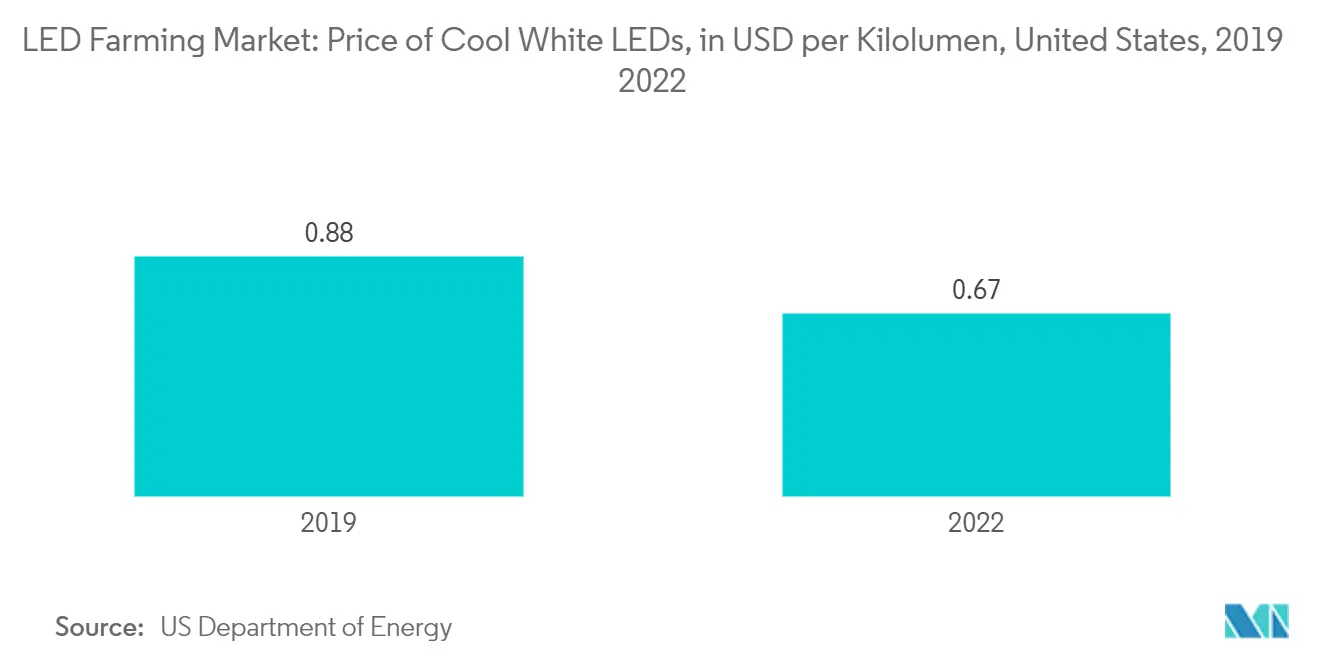
North America holds the Largest Market in LED Farming
North America holds the largest share of the global LED farming market, with the United States contributing the most significant portion of the region's revenue. The United States faces farmland scarcity and an increasing need for higher crop productivity. According to the latest survey, the number of farms in the United States decreased from 2.04 million in 2017 to 1.89 million in 2023, a 7% decline. Similarly, land used for farms continued to decrease, dropping from 900 million acres in 2017 to 879 million acres in 2023. This reduction in agricultural land supports the establishment of vertical farms to provide fresh produce to consumers, driving the growth of LED farming.
A significant challenge in the industry is the lack of knowledge and experience in maximizing crop productivity in controlled environments. To address this, the Agricultural Research Service (ARS) initiated a Grand Challenge synergy project on controlled environment agriculture (CEA) in 2018. This nationally coordinated research effort aims to generate knowledge for both greenhouse and vertical farming practices by improving various aspects, including plant genetics, LED lighting, environment control, hydroponic/aquaponic nutrient solutions, pest and disease management, and food quality and safety practices. These initiatives has driven the vertical farming trend and increased LED farming adoption due to improved productivity and profitability.
The continuous launch of vertical farms by companies in the region supports the increased use of LED lights for plant growth. For instance, in 2023, Square Roots opened its fourth farm in Kentucky, United States, further expanding the use of LED farming technology. In Canada, a growing preference for "fresh-from-farm-to-table" consumption has encouraged several players, such as Modular Farms, Goodleaf Farms, Nova Scotia's TruLeaf, and Ecobain Gardens, to turn to urban agriculture. This trend addresses periodic food supply issues in the country and increases the adoption of LED farming technology. These factors collectively support the growth of the LED farming market in North America during the forecast period.
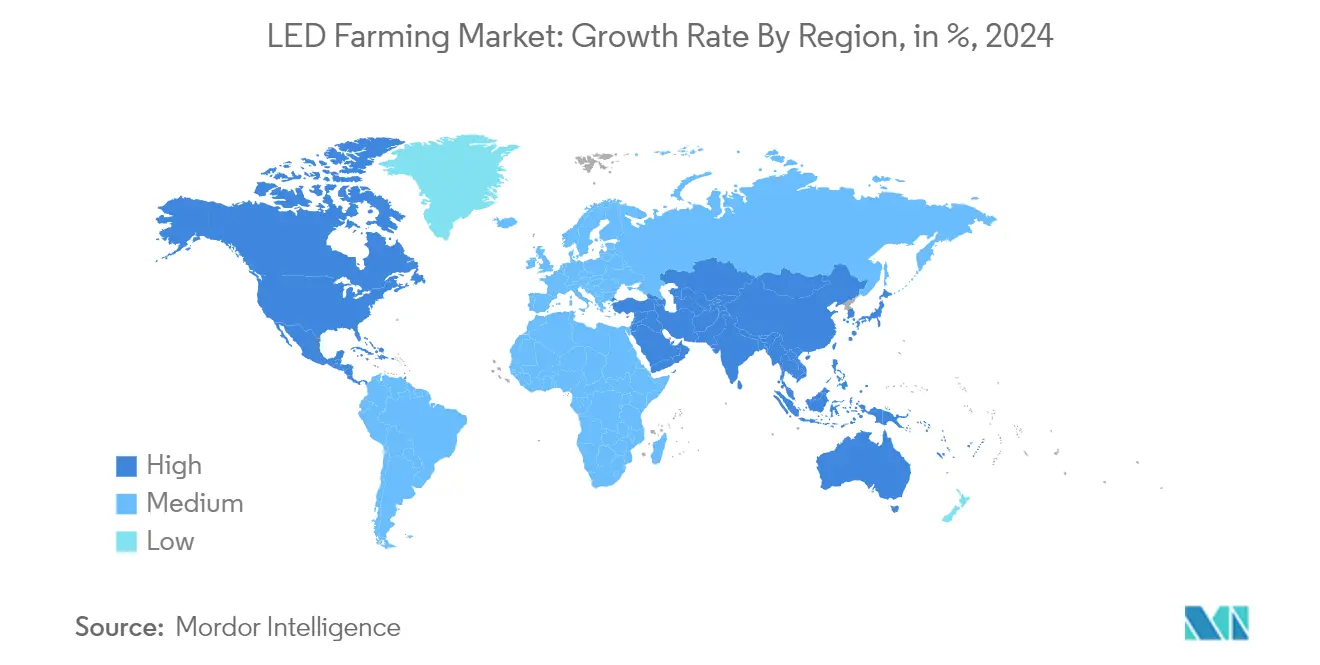
Competitive Landscape
The market is highly fragmented, with a few internationally established players as well as several regional players vying for a higher market share in the emerging market for LED lights in farming. The key players in the market include Koninklijke Philips N.V., Gavita International B.V., Savant Systems, Inc., ams-OSRAM AG., and Heliospectra, among others, occupying a higher share in the world.
LED Farming Industry Leaders
-
Koninklijke Philips N.V.
-
Gavita International B.V.
-
Savant Systems, Inc.
-
ams-OSRAM AG.
-
Heliospectra
- *Disclaimer: Major Players sorted in no particular order
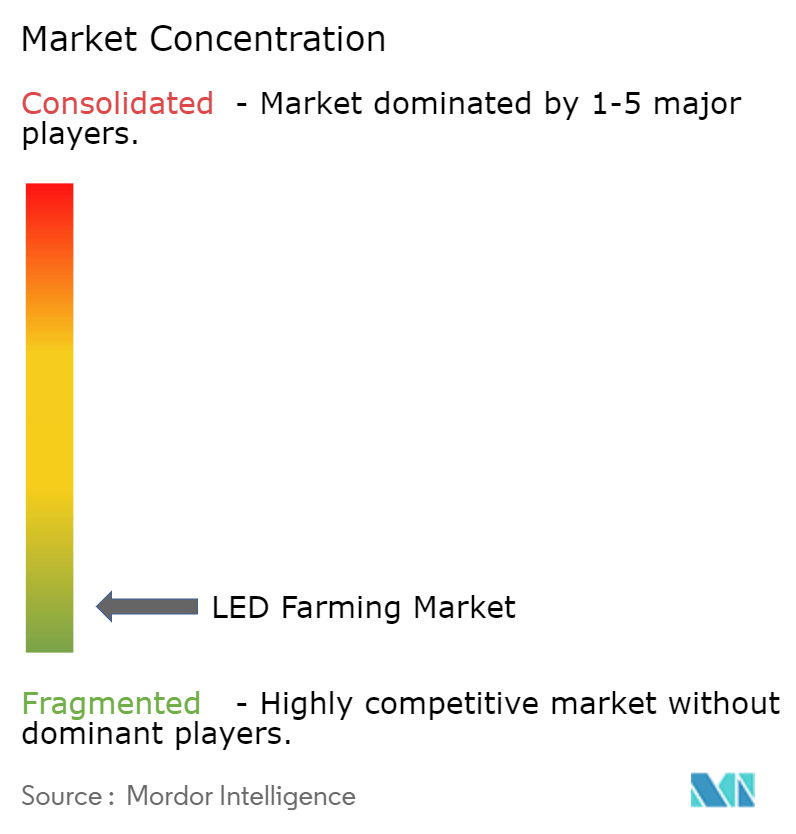
Recent Industry Developments
- June 2023: Oreon company launched a new multilayer LED fixture called Embrace XL which is specially developed for vertical and indoor farming. This is a multifunctional multilayer LED fixture that can be installed in any rack system in the farms.
- January 2023: Polymatech Electronics India’s first semiconductor chip manufacturer specializing in Opto-semiconductors launched new horticulture LED products, RavayeTM full-spectrum packages and modules, as well as monochromatic LEDs, which are aimed at providing enhanced greenhouse and vertical farming lighting for professional horticulture applications.
- September 2022: Signify provided the installation of a full-length Philips GreenPower LED toplighting force at Van Wordragen Flowers BV by replacing 4.3 hectares of HPS lighting with Philips GreenPower LED lighting.
Global LED Farming Market Report Scope
LED lighting is widely used in agriculture due to its effectiveness in providing optimal light conditions for plant growth. LEDs offer adjustable light spectrums that stimulate natural sunlight, supporting photosynthesis and improving crop quality and yield. The LED Farming Market report is segmented based on Application (Vertical Farming, Indoor Farming, Commercial Greenhouse, Turf & Landscaping, and Other Applications), Wavelength (Blue Wavelength, Red Wavelength, and Far Red Wavelength), Crop Type (Fruits & Vegetables, Herbs & Microgreens, Flowers & Ornamentals, and Other Crop types) and Geography (North America, Europe, Asia-Pacific, South America, and Middle East & Africa). The report offers market size and forecast in terms of value (USD) for all the segments.
| Vertical farming |
| Indoor Farming |
| Commercial Greenhouse |
| Turf and Landscaping |
| Blue Wavelength |
| Red Wavelength |
| Far Red Wavelength |
| Fruits & Vegetables |
| Herbs & Microgreens |
| Flowers & Ornamentals |
| Other Crop Types |
| North America | United States |
| Canada | |
| Mexico | |
| Rest of North America | |
| Europe | Germany |
| United Kingdom | |
| France | |
| Russia | |
| Spain | |
| Rest of Europe | |
| Asia Pacific | China |
| Japan | |
| India | |
| Australia | |
| Rest of Asia-Pacific | |
| South America | Brazil |
| Argentina | |
| Rest of South America | |
| Middle East and Africa | United Arab Emirates |
| Saudi Arabia | |
| South Africa | |
| Egypt | |
| Rest of Middle East and Africa |
| Application | Vertical farming | |
| Indoor Farming | ||
| Commercial Greenhouse | ||
| Turf and Landscaping | ||
| Wavelength | Blue Wavelength | |
| Red Wavelength | ||
| Far Red Wavelength | ||
| Crop Type | Fruits & Vegetables | |
| Herbs & Microgreens | ||
| Flowers & Ornamentals | ||
| Other Crop Types | ||
| Geography | North America | United States |
| Canada | ||
| Mexico | ||
| Rest of North America | ||
| Europe | Germany | |
| United Kingdom | ||
| France | ||
| Russia | ||
| Spain | ||
| Rest of Europe | ||
| Asia Pacific | China | |
| Japan | ||
| India | ||
| Australia | ||
| Rest of Asia-Pacific | ||
| South America | Brazil | |
| Argentina | ||
| Rest of South America | ||
| Middle East and Africa | United Arab Emirates | |
| Saudi Arabia | ||
| South Africa | ||
| Egypt | ||
| Rest of Middle East and Africa | ||
Key Questions Answered in the Report
How big is the LED Farming Market?
The LED Farming Market size is expected to reach USD 5.15 billion in 2025 and grow at a CAGR of 12.20% to reach USD 9.16 billion by 2030.
What is the current LED Farming Market size?
In 2025, the LED Farming Market size is expected to reach USD 5.15 billion.
Who are the key players in LED Farming Market?
Koninklijke Philips N.V., Gavita International B.V., Savant Systems, Inc., ams-OSRAM AG. and Heliospectra are the major companies operating in the LED Farming Market.
Which is the fastest growing region in LED Farming Market?
Asia Pacific is estimated to grow at the highest CAGR over the forecast period (2025-2030).
Which region has the biggest share in LED Farming Market?
In 2025, the North America accounts for the largest market share in LED Farming Market.
What years does this LED Farming Market cover, and what was the market size in 2024?
In 2024, the LED Farming Market size was estimated at USD 4.52 billion. The report covers the LED Farming Market historical market size for years: 2019, 2020, 2021, 2022, 2023 and 2024. The report also forecasts the LED Farming Market size for years: 2025, 2026, 2027, 2028, 2029 and 2030.
Page last updated on:
LED Farming Market Report
Statistics for the 2025 LED Farming market share, size and revenue growth rate, created by Mordor Intelligence™ Industry Reports. LED Farming analysis includes a market forecast outlook for 2025 to 2030 and historical overview. Get a sample of this industry analysis as a free report PDF download.
